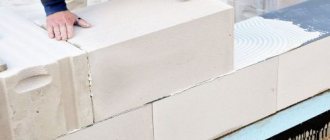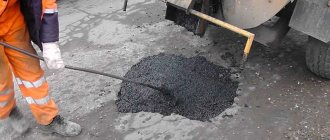0
20.11.2021
One of the important stages of repair is the identification and repair of mechanical defects. These include various holes and cracks. The nature of the appearance of such deficiencies varies. Holes may appear when laying or replacing pipes, installing an air conditioner, or mechanical impact from tools. Some materials can be damaged by mice or other rodents. In any case, it is important to know how to repair a hole in the wall.
Holes in the walls must be sealed.
Causes of holes
Page navigation
Any surface can crumble or collapse. Cracks appear in different rooms - bathrooms, hallways, kitchens. Before you try to cover up a hole in the wall, it is important to determine the reasons for its appearance.
The hole may appear due to inadequate load on the structure or as a result of errors in soil compaction. In such a situation, you need to cover up the holes only after eliminating the problems of shrinkage and strengthening the foundation. Pronounced displacements of the structure can provoke the collapse of walls and ceilings.
The formation of cracks may be the result of the influence of climatic factors. These include sharp temperature fluctuations, wind, and sunlight. The joints between the internal and external walls on the stairs and high floors of the building suffer the most.
The formation of defects may be a consequence of the concrete solution drying out after some time. Reinforced concrete structures are associated with an increased risk of through holes.
Deformations on concrete can occur when attaching shelves, cabinets, and lamps. The problem also arises when moving switches and sockets.
Thus, the key reasons for the formation of holes in the walls include the following:
- natural shrinkage of a new house;
- influence of external factors;
- replacing or moving pipes;
- installation of switches and sockets;
- laying communications through walls;
- fastening shelves, decorative elements of cabinets;
- mechanical damage.
Very rarely does a hole appear in the wall just like that, there is always some reason
What tools will you need?
Many people are interested in how to repair a hole in the wall. To begin with, it is important to choose the right tools. For this purpose the following should be used:
- brushes that have hard bristles;
- spatulas of different widths;
- brush;
- foam sponge;
- gun for working with polyurethane foam or sealant;
- perforator;
- hammer.
To seal holes in the wall, it is important to prepare the necessary tools.
When choosing a sealing method, you should take into account the characteristics of the wall material. For structures made of brick and concrete, you can use a cement mortar with the addition of plasticizers. It is permissible to seal the plastered surface with putty. It can also be plastered with Rotband or any other product. A small hole can be repaired with sealant.
When carrying out work, you should not only choose the coating composition, but also the method of its application.
So, the hole in the drywall needs to be filled with putty. The cracks in wooden walls should first be caulked and then covered with a special putty. To reinforce the hole you need a fiberglass mesh.
Most often, a cement composition is used to seal holes. It can be used externally or internally. In this case, you should choose a solution for a specific type of work.
Even an inexperienced person can mix the cement mixture
To make the mixture, it is recommended to mix sand and cement in a 3:1 ratio. You also need to add PVA and water to the composition. The result should be a medium thick consistency.
On sale you can find ready-made dry formulations that need to be diluted with water in accordance with the proportions indicated on the package.
For indoor work, lime-based compositions can be used. To make the mixture, it is recommended to take lime and sand in a ratio of 1:4. You need to add water to this composition. The solution should not be too thick or too thin.
A putty solution is considered an effective remedy. It has the consistency of a paste and is used when it is necessary to level the base and eliminate small defects.
Cement putty can be used for interior and exterior work. The main advantages of the material include its strength and moisture resistance. It is important to consider that the composition does not dry very quickly and does not have a high degree of plasticity.
Gypsum-based putties are also suitable for indoor work. They can be used in rooms with normal microclimate. The main advantage of such products is considered to be a high degree of plasticity.
The store sells ready-made formulations
Repairing a breach with foam
Large holes, cracks and potholes in a concrete wall are sealed with polyurethane foam:
- The problem area is deepened and cleared of dirt and dust.
- The area is moistened with a sprayer for better adhesion of the foam to the surface.
- Before spraying, shake the foam canister and apply the product from bottom to top. The foam increases in volume, so the area is not filled to its full depth.
- After drying, excess foam is cut off with a sharp knife a little deeper than the wall level.
- The required area is leveled with the solution until it hardens completely.
- The patch is puttied and sanded after drying.
The foam has a high ability to penetrate into the most inaccessible and small areas. In 24-48 hours it fills the desired area, after which the excess is removed.
For repair work with potholes in rooms with low air temperatures, frost-resistant polyurethane foam is used. Restoration of deep seams, cracks and interpanel discrepancies requires the presence of a special device - a foam gun, which will provide better quality and ease of work.
The sequence of sealing seams with foam is no different from eliminating holes. Deep cracks and gaps are foamed in layers. After one layer has completely dried, the next one is applied. When working with polyurethane foam, you must be careful, as it sticks tightly to clothing and the body.
How to cover up a hole from dowels during repairs
Sometimes holes appear in walls as a result of drilling with a hammer drill or other tool. How can you cover up holes in the wall from dowels, screws or self-tapping screws?
For this purpose, it is recommended to do the following:
- Remove concrete debris with a vacuum cleaner.
- Moisten the cavity generously with water. For this purpose, you can use a brush or spray.
- Seal the hole in the wall with a putty knife. In this case, it is permissible to putty it or use a repair mixture.
- Apply putty in several layers with intermediate surface treatment with sandpaper. This will help achieve an even structure without deepening.
- When using a repair mixture, apply a layer of putty. This will help level the surface.
This method is suitable for eliminating a small hole in the wall - up to 50 mm. How to seal a hole in the wall from a larger dowel? A deep hole must first be filled with foam. After this, you can resort to the described technology.
The method for sealing a dowel hole depends on its size.
Reconstruction of walls after relocation of sockets
When moving sockets, excess recesses must be sealed with gypsum or cement mortar. The technology for carrying out such work largely depends on the depth of the hole. If it exceeds 5 cm, then you will definitely need a piece of foam plastic or a stone of appropriate dimensions.
Compliance with the correct sequence of restoration work guarantees a perfectly level base.
Attention! It is forbidden to blow dust out of the hole: there is a high probability of injury to your eyes. A household vacuum cleaner is best suited in this situation.
A method for eliminating large holes from a set of sockets and wires
If there are large holes left in the room from the installation of sockets, you need to do the following:
- Get rid of dust and other contaminants.
- Treat with a regular primer.
- Place brick chips or crushed stone into the large hole.
- Mix 1 part cement with 3 parts sand and dilute the resulting composition with water.
- Seal the holes with a spatula and leave for 12 hours.
- Do the final leveling and putty the walls until smooth.
At the puttying stage, it is recommended to finish the entire wall completely. Only after this can you move on to decorative cladding or wallpapering.
The hole from the sockets must be sealed with a cement-sand mixture.
How to fill a large hole
Most often you will find large holes in very old buildings. They are caused by a combination of masonry moisture, frost and mechanical wear.
A thorough restoration, a structural engineer's review and an overall assessment by an expert should always go hand in hand with their renovation.
The repair procedure itself is as follows:
- Clear the opening area of debris, dust and other debris. Wet the surface.
- Cover the damaged area with dry bricks. To secure individual parts, special tile adhesive is used.
- Fill the rest of the hole with solution and let it dry for 2-3 days.
Holes in the ceiling after falling plaster
The easiest way is to cover the damaged area with a new layer of plaster. However, this option is not considered very good, since the hole will appear again in the near future.
To completely fix the problem, it is important to do the following:
- Before attempting to seal the hole, the damaged area should be thoroughly cleaned. It is important to do this as carefully as possible.
- Then it is necessary to treat the surface with an antifungal substance. The fact is that it is a fungal infection that most often leads to crumbling of plaster.
- At the next stage, treat the damaged area and adjacent areas with a primer layer.
- Putty the coating in 2-3 layers. This depends on the required thickness. It is important to dry each layer thoroughly.
- Rub down the ceiling and prime again.
Repairing damage to the ceiling has certain features.
Expert advice
Restoration of any defect in the wall does not require special knowledge and skills in the field of construction. But, before starting repair work, it is important to prepare the necessary materials and study the process of eliminating various holes. This will prevent you from making serious mistakes later, which means getting a high-quality result. In addition, it is worth considering the following rules for repairing all kinds of damage on the surface of the walls:
If the renovated area is not subjected to excessive loads and the room is used correctly, then you don’t have to worry about repeated destruction of the foundation.
Through holes
If through holes appear in the wall, it is important to take a different approach. How to cover such holes in a concrete wall? If the tool goes through, the hole must be covered on both sides.
To do this, you must first cover it with a piece of stone or brick. After this, a mixture of sand and cement should be applied to the problem area. It is first laid on one side, and then on the other.
After the solution has dried, it is recommended to apply finishing plaster. You should also be sure to sand the surface.
If there is no access to the opposite wall, the problem can be solved as follows:
- Install 4 dowels near the hole, which will become a kind of support for the stone.
- Seal the hole with a piece of stone. It should be adjusted to the size of the hole.
- Strengthen the stone. This must be done with a solution based on cement and sand. It should be mixed in a ratio of 1:3.
- After the substance has dried, level the damaged area with plaster and sand it with sandpaper.
The final treatment of the wall is done with plaster
Cracks at joints
Many people are interested in how to fix a hole in the wall if it appears at the junction. To do this, you need to use the same approach as for walls. However, there are some differences.
The main feature is the need to expand the crack. To do this, it is increased to 6-12 mm along its entire length.
The appearance of cracks and holes in an apartment is considered a rather unpleasant problem. To cope with it, it is important to establish the nature of the damage. To seal problem areas, cement-sand mixtures, gypsum, putty, and alabaster are used.
Where do you start sealing cracks?
First of all, you need to thoroughly clean the surface. Even if the gap is very small in appearance, the ceiling next to it must be cleaned very well with a spatula. Most likely, as soon as you remove the layer of putty, you will see the actual size of the gap, which may not be small at all.
Next, you need to continue cleaning the gap with a spatula, knife, in general, with any tool suitable for these purposes. Builders call this procedure “joint jointing.”
You need to completely free the gap from old, dried out mortar. When building a house, the cracks are filled with ordinary cement, but over time it loses its strength: rain, temperature changes, and again shrinkage. It is advisable not to leave a single extra pebble or piece of cement, since it will then prevent the new material from “grabbing” well.
After you have completed this work, we move on to another stage, also preparatory.











